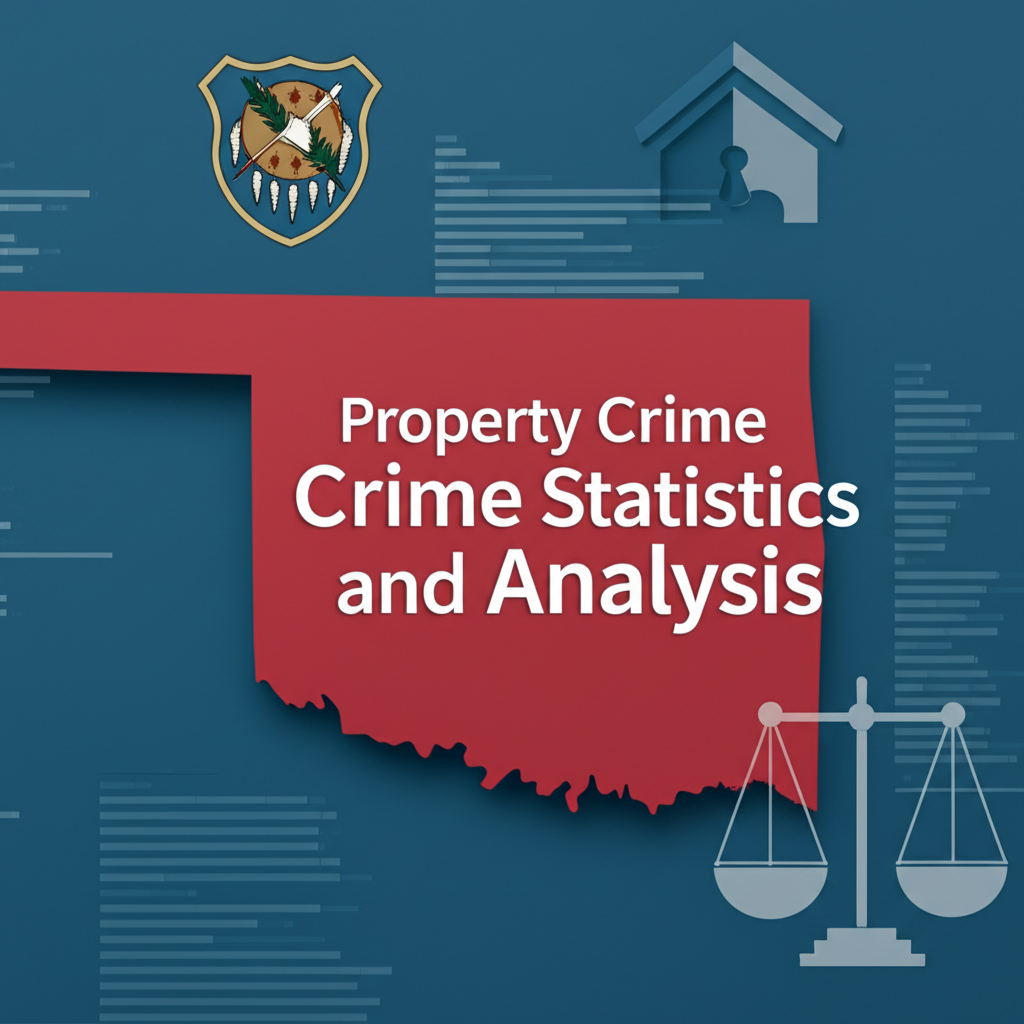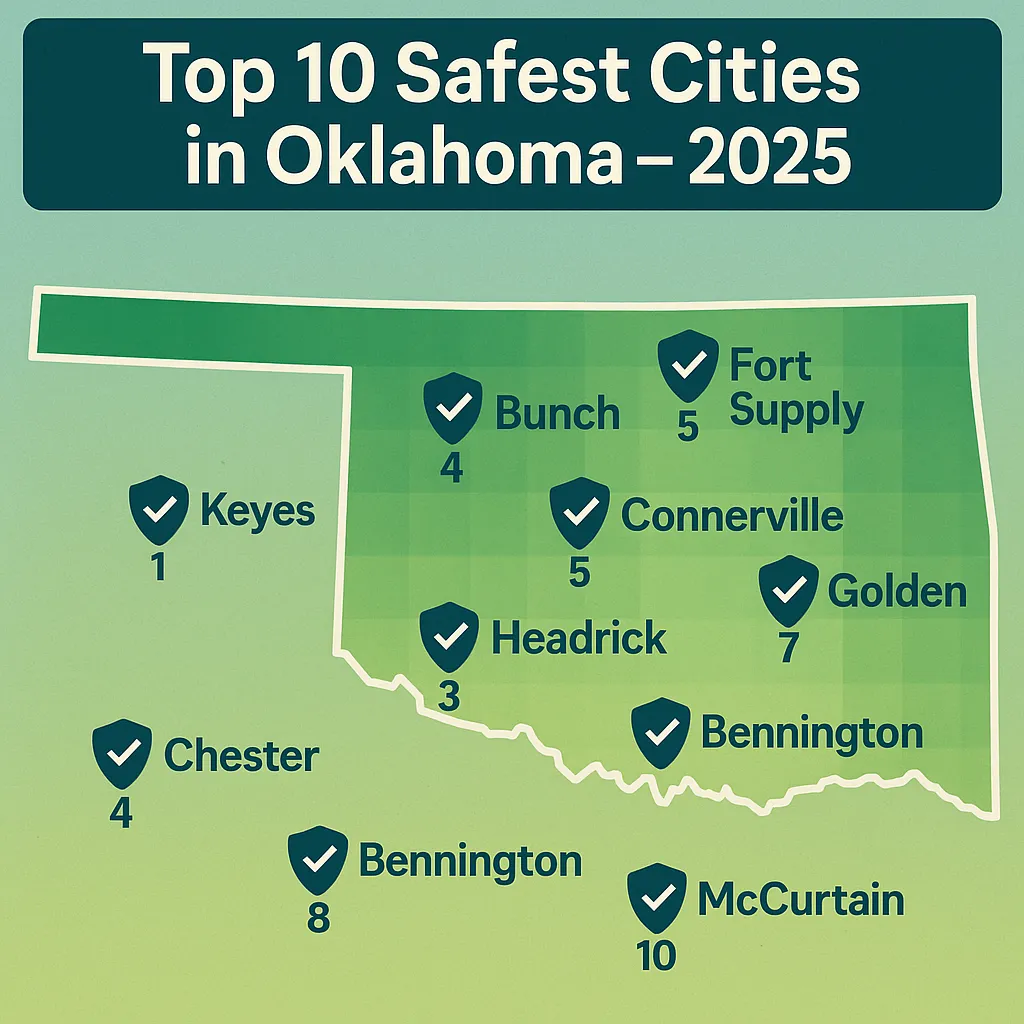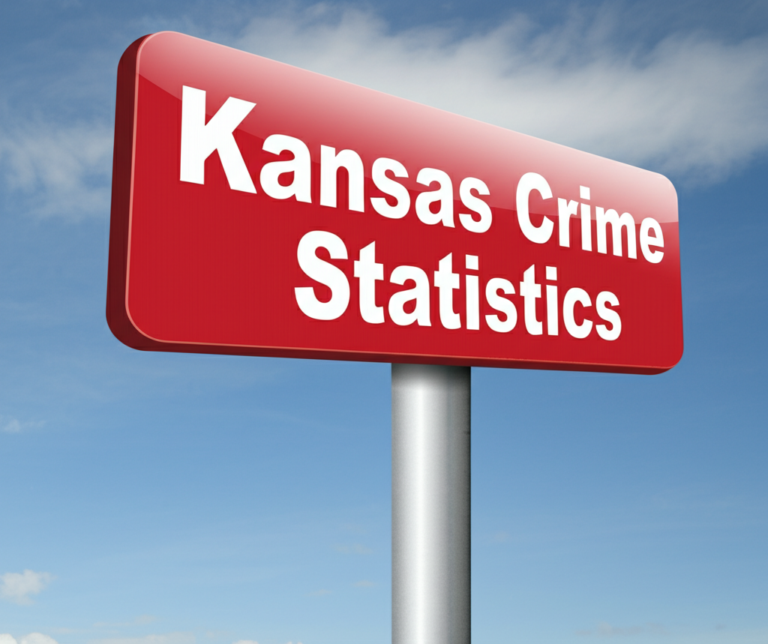Oklahoma Crime Rate 2025: In-Depth Analysis of Crime Statistics and Safety
Oklahoma faces a complex landscape when it comes to crime and public safety. Understanding the trends and nature of criminal activity across the state is crucial for residents, policymakers, and law enforcement agencies alike. This wide-ranging overview covers how crime statistics shape safety protocols and community responses. Both violent crime and property crime rates reflect conditions that influence law enforcement strategies and prevention efforts. These patterns provide a snapshot of safety concerns that impact the everyday lives of Oklahomans.
- Oklahoma reports a total crime rate of 25.62 per 1,000 residents.
- The state has distinct rates for violent and property crimes, influencing public safety measures.
- Data reflects a comprehensive analysis of reported crimes collected nationwide.

Overview of Crime Types in Oklahoma
Exploring the types of crime prevalent in Oklahoma offers a deeper understanding of the state’s safety environment. The total number of reported crimes stands at 103,867, a figure that encompasses a wide array of unlawful activities. Within this, violent crime accounts for a rate of 4.14 incidents per 1,000 residents, while property crime occurs more frequently, at 21.49 per 1,000 residents. These categories include offenses under both criminal law and the work of law enforcement. Such detailed crime statistics are essential for the criminal justice system’s planning and response.
- Total crimes reported: 103,867.
- Violent crime rate per 1,000 residents is 4.14.
- Property crime rate per 1,000 residents is 21.49.
| Crime Category | Reported Total | Rate per 1,000 Residents |
|---|---|---|
| Overall Crimes | 103867 | 25.62 |
| Violent Crimes | 16770 | 4.14 |
| Property Crimes | 87097 | 21.49 |
Detailed Violent Crime Statistics in Oklahoma

Violent crime in Oklahoma includes serious offenses such as murder, rape, robbery, and assault. These crimes are of particular concern due to their direct impact on individuals’ safety. Among these, assault represents the highest incidence, with a rate of 3.12 per 1,000 residents, indicating that physical attacks occur frequently. The overall violent crime rate stands at 4.14 per 1,000 residents, meaning that the chance of victimization is roughly 1 in 242.
The data provides crucial insights for law enforcement planning and emphasizes the ongoing challenge of addressing violence through criminal law enforcement. For more details, the FBI’s official resources offer an extensive view at https://www.fbi.gov/services/cjis/ucr.
- Violent crimes include murder, rape, robbery, and assault.
- Assault has the highest rate among violent crimes at 3.12 per 1,000 residents.
- Victimization chance for violent crime is approximately 1 in 242.
| Crime Type | Reported Total | Rate per 1,000 Residents |
|---|---|---|
| Murder | 247 | 0.06 |
| Rape | 2376 | 0.59 |
| Robbery | 1510 | 0.37 |
| Assault | 12637 | 3.12 |
| Total Violent Crimes | 16770 | 4.14 |
Comparison of Violent Crime Rates with National Averages
When comparing Oklahoma’s violent crime rates to the national averages, some interesting observations emerge. The murder rate matches the national figure exactly, at 0.06 cases per 1,000 residents. However, the rate of rape in Oklahoma is noticeably higher, recorded at 0.59 compared to the national average of 0.38. For robbery and assault, the numbers fluctuate differently; robbery occurs less frequently than the national rate, while assault rates in Oklahoma exceed those seen nationwide. These comparisons help inform public conversations about national security and highlight where focused efforts may be needed. More comprehensive crime comparison data is available at https://www.bjs.gov.
- Oklahoma’s murder rate matches the national rate at 0.06 per 1,000 residents.
- Rape rate in Oklahoma exceeds the national average with 0.59 vs. 0.38.
- Robbery and assault rates show mixed trends compared to national data.
| Crime Type | Oklahoma Rate per 1,000 | U.S. National Rate per 1,000 |
|---|---|---|
| Murder | 0.06 | 0.06 |
| Rape | 0.59 | 0.38 |
| Robbery | 0.37 | 0.67 |
| Assault | 3.12 | 2.64 |
Property Crime Statistics and Analysis

In Oklahoma, property crime is much more prevalent than violent offenses. Among these, theft dominates, with a rate of 14.26 per 1,000 residents, illustrating how common these incidents are. Burglary and motor vehicle theft also make significant contributions to property crime totals. These offenses directly impact public safety and community well-being. The statistics highlight the importance of robust law enforcement efforts to protect residents’ homes and belongings, and to prevent losses that affect families and businesses. Understanding these patterns helps frame crime prevention policies in Oklahoma.
- Property crimes are much more common than violent crimes in Oklahoma.
- Thefts dominate property crimes with a rate of 14.26 per 1,000 residents.
- Burglary and motor vehicle theft also contribute substantially to crime totals.
| Property Crime Type | Reported Total | Rate per 1,000 Residents |
|---|---|---|
| Burglary | 18586 | 4.58 |
| Theft | 57816 | 14.26 |
| Motor Vehicle Theft | 10695 | 2.64 |
| Total Property Crimes | 87097 | 21.49 |
Property Crime Rate Comparison to National Data
Comparing Oklahoma’s property crime numbers with the national data reveals several contrasts. The state experiences a higher rate of burglary, sitting at 4.58 per 1,000 residents, noticeably above the U.S. average of 2.51. Theft rates are also slightly elevated in Oklahoma compared to the national average. Conversely, motor vehicle theft happens less frequently here than across the country. Such comparisons illuminate how localized factors influence crime statistics and underline where prevention resources might best be applied. Those interested in detailed insights can consult the FBI’s crime reports at https://www.fbi.gov/services/cjis/ucr.
- Oklahoma exceeds national burglary rates with 4.58 vs. 2.51 per 1,000.
- Theft rates are slightly above the U.S. average.
- Motor vehicle theft in Oklahoma is below the national median.
| Property Crime Type | Oklahoma Rate per 1,000 | U.S. Rate per 1,000 |
|---|---|---|
| Burglary | 4.58 | 2.51 |
| Theft | 14.26 | 13.47 |
| Motor Vehicle Theft | 2.64 | 3.19 |
Crimes Per Square Mile in Oklahoma versus National Median
Looking at the density of crime, Oklahoma reports 15 crimes per square mile. This number is lower than the national median of 26.5 crimes per square mile. This reduced concentration can influence how law enforcement allocates resources and how residents perceive public safety. Lower crime density may provide some communities more peace of mind, although it does not eliminate the need for vigilance. These metrics help shape responses to crime in both urban and rural areas across Oklahoma.
- Oklahoma reports 15 crimes per square mile, below the national median of 26.5.
- This lower density of crime may influence perceptions of safety and law enforcement resource allocation.
| Location | Crimes Per Square Mile |
|---|---|
| Oklahoma | 15 |
| U.S. National Median | 26.5 |
Top Safest Cities in Oklahoma with Crime Rates

Certain cities in Oklahoma have earned reputations as among the safest statewide, providing communities where low crime rates help foster a secure environment. Places like Keyes and Bunch top the list, followed by other towns such as Headrick, Chester, and Connerville. The top ten safest cities all consistently show lower crime levels compared to broader Oklahoma statistics. These rankings serve as useful guides for individuals and families considering relocation or seeking areas with strong law enforcement and community safety.
- Keyes and Bunch are among the safest cities in Oklahoma.
- The top 10 safest cities all show consistently low crime rates compared to statewide averages.
| City | Rank |
|---|---|
| Keyes | 1 |
| Bunch | 2 |
| Headrick | 3 |
| Chester | 4 |
| Connerville | 5 |
| Fort Supply | 6 |
| Golden | 7 |
| Bennington | 8 |
| Hanna | 9 |
| McCurtain | 10 |
Popular Cities in Oklahoma and Crime Considerations
Oklahoma’s more populated cities like Oklahoma City, Tulsa, and Norman display diverse crime profiles due to the variety of neighborhoods and population densities involved. While these metropolitan areas report higher absolute crime totals, the actual crime rates vary widely. Cities such as Broken Arrow and Moore are experiencing growing populations, which can affect local crime dynamics.
Understanding these differences allows both residents and visitors to stay informed and prioritize public safety strategies. For current and detailed crime statistics, the Oklahoma Criminal Justice Resource Center provides valuable information at https://www.ok.gov/ocjs/Crime_Statistics.
- Cities like Oklahoma City, Tulsa, and Norman have diverse crime profiles.
- These populous cities see higher absolute crime totals but varying crime rates.
- Understanding crime in these cities helps residents and visitors stay informed and safe.
| City | Crime Profile |
|---|---|
| Oklahoma City | Higher absolute crimes with varying rates |
| Tulsa | Moderate to high crime levels |
| Norman | Lower crime compared to larger cities |
| Broken Arrow | Growing population with changing crime |
| Lawton | Variable crime reports |
| Midwest City | Moderate crime levels |
| Moore | Growing suburban crime dynamics |
Understanding Crime Data Collection and Reporting Methodology

The comprehensive crime data for Oklahoma arises from a collaborative effort across more than 18,000 law enforcement agencies nationwide. The methodological approach integrates over 9 million reported crimes, with data including precise geographical locations. This extensive database is carefully adjusted to correct for common issues such as non-reporting and data errors, ensuring the accuracy of overall crime statistics.
The Federal Bureau of Investigation (FBI) alongside the Oklahoma State Bureau of Investigation (OSBI) play pivotal roles in collecting and updating these figures regularly. Those interested in the methodology can learn more at https://www.fbi.gov/services/cjis/ucr.
- Data sources include 18,000 law enforcement agencies across the nation.
- The methodology involves analysis of over 9 million reported crimes with geo-locational data.
- Adjustments are made for underreporting and errors to provide accurate crime statistics.
Conclusion
In conclusion, the analysis of crime in Oklahoma reveals a complex interplay between violent and property crimes, with significant implications for public safety and law enforcement strategies. The state’s crime statistics, including higher rates of burglary and assault compared to national averages, underscore the need for targeted interventions. Meanwhile, the presence of safer cities like Keyes and Bunch offers hope and models for crime prevention. Understanding these dynamics is crucial for developing effective policies and fostering safer communities across Oklahoma.




